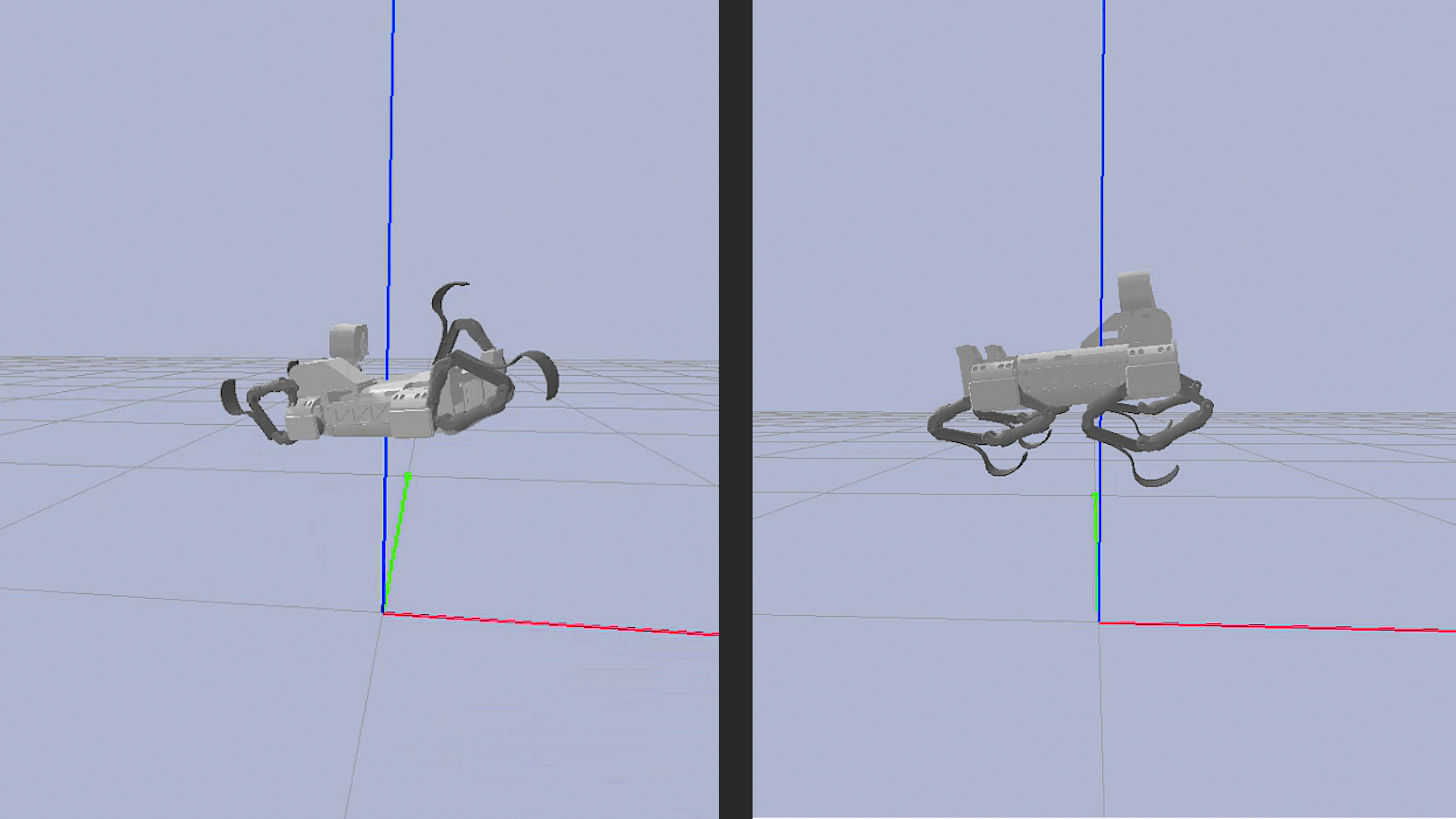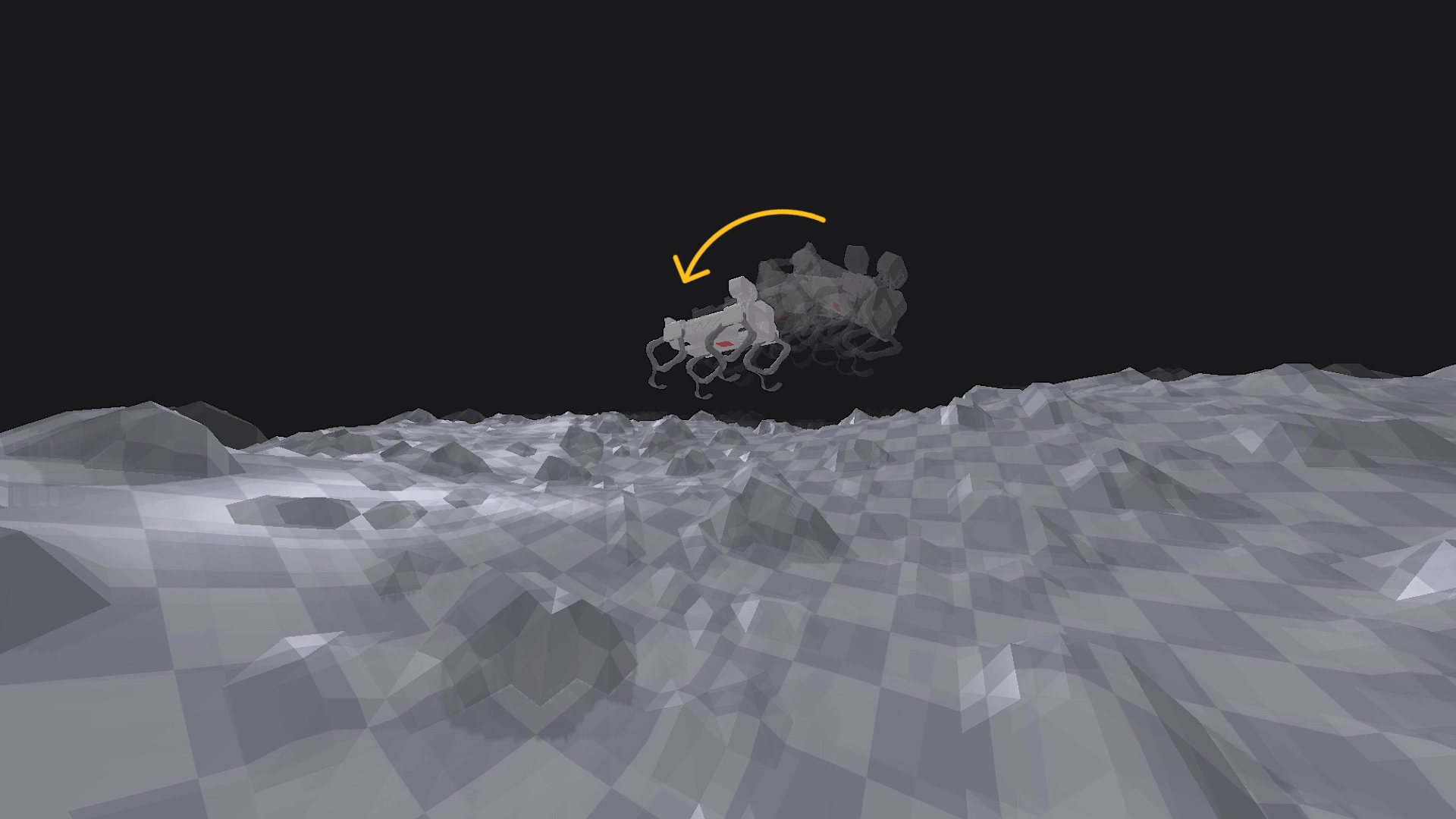Modeling Attitude Control in Microgravity
Building on earlier empirical and simulation-based work, this month focused on defining the mathematical model that describes how internal leg movements can influence the robot's global orientation in microgravity. The system was modelled as a non-holonomic free-floating body, with no external torque or fixed base. As in the classic falling cat problem, reorientation must emerge entirely from internal actuation - specifically, coordinated changes in the robot's limb configuration. The body was described with 6 DoF, but control efforts focused on roll (ϕ) and pitch (θ). Each leg has 2 DoF (extension and swing), giving 8 independent inputs. Using this, the control problem was defined as an underdetermined linear system, where the Jacobian:

maps joint velocities to changes in roll and pitch rates:

A Constraint-Aware Bandit
In February, the control architecture for Continuity took a substantial step forward with the formal integration of the bandit-based decision layer into the QuectoFSM state machine framework. This was the first implementation of what I termed Constrained Local Learning (CLL): a structure where bandit-based exploration is actively gated by contextual rules, and actions are only permitted when predefined safety and state conditions are satisfied. The multi-armed bandit (MAB) component, now in version 3, moved beyond basic reward selection and hard-coded action cycling. Instead of optimising only low-level parameters (e.g., step height or cycle duration), the new system could also select from a list of gait patterns, each encoded as an arm with an associated performance history. To regulate instability, the bandit’s reward function was overhauled. The original inverse formulation:

was replaced by a log-scaled penalty system, better suited for sharply discouraging large attitude deviations while maintaining sensitivity around small corrections:


Virtual Actuators and Inertial Reorientation
 Watch: Closed Kinematics Loop problem, old VS new approach
Watch: Closed Kinematics Loop problem, old VS new approach
In January, I revisited one of the earliest and most persistent simulation challenges: the closed kinematic chain used in each of Continuity’s legs. URDF lacks native support for closed loops, and PyBullet's rigid body solver struggles with stability when constraints are not explicitly enforced. Previous attempts relied on “fake” revolute joints between femurs and tibias, but these caused instability, especially under dynamic movement, with the robot occasionally entering oscillatory or jumping states. After extensive debugging and physical intuition testing, I adopted a hybrid constraint approach. The solution involved modelling the leg’s closed geometry indirectly via a set of virtual actuators: each tibia’s angle was no longer explicitly controlled, but derived as a function of its corresponding femur's motion using precomputed constants:

This mimicked the effect of parallel bars closing the linkage while retaining numerical stability. The result was a marked reduction in unintended vertical impulses and more consistent leg trajectories across the gait cycle.
Reorientation and Bandit-Based Autonomy
 Watch: Self-reorientation attempt using Contextual MAB
Watch: Self-reorientation attempt using Contextual MAB
During November and December, the project's focus shifted toward a more abstract - but mission-critical - aspect of legged mobility: attitude control and self-reorientation in microgravity conditions. While locomotion on uneven terrains remained a long-term goal, this phase initiated the development of strategies for reorienting a free-floating rigid body using only internal leg motions, without relying on external contacts or torque sources. This involved modelling Continuity as a non-holonomic system in microgravity, where angular momentum is conserved, and reorientation must occur through the redistribution of internal masses - specifically, the four legs. The problem setup mirrors the classical "falling cat" scenario, where a free-floating body must execute sequences of internal movements to rotate in space despite zero net external torque.